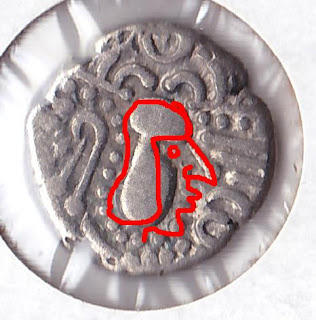Here's another coin show purchase. It is Indo-Sasanian drachm, and I have tentatively identified this as a Chaulukya Dynasty era coin from Saurashtra, Gujarat, or Malwa in western
The obverse shows the stylized head of a Sasanian king, and the reverse shows a fire altar with two attendants.
...What, you can't see it? I'll outline the pertinent features in red to make them more obvious.
The design is hard to see because this is an example of something one sees from time to time in ancient coins: A very popular design that outlives its cultural context but keeps getting repeated. Over time, the people making and using the coins lose consideration of, or just forget, the original meaning of the symbols on the coin, and just keep using them because that's what money is supposed to look like. This means that the imagery becomes stylized and warped as it is repeated over the decades and centuries, sort of like a message being passed from person to person in that telephone game.
This coin was probably minted centuries after the deaths of the Sasanian king or kings that were depicted on the original coins. I don't know whether or not the die maker knew what he was depicting. Did he know this was the bust of a long-dead king, an altar with two sets of arms tending to the ritual? Did he ever see an example of the older coins?




Thanks for outlining. Very interesting. How many foreign countries have people who metal detect, do you think?
ReplyDeleteVery interesting. But I think the most interesting thing was "how did you do an outline on the coin picture?"
ReplyDeleteCool coins! And fun to look at - I never would have guessed the images without the outlining. Made me want to google the era and dynasty...the temples from that time contained alot of detailed sculptures - the stylized images on the coins look so different.
ReplyDelete